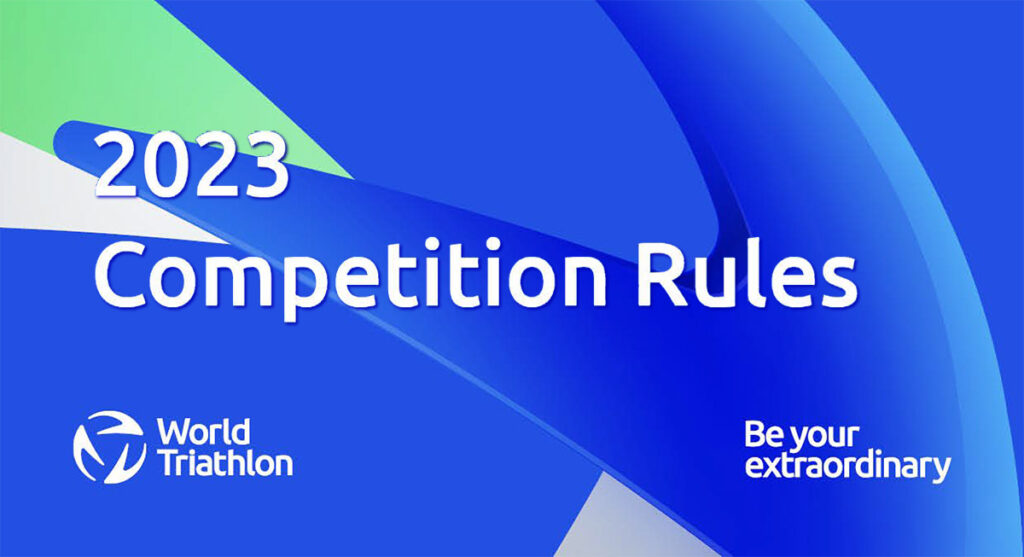On December 1st World Triathlon published the 2023 edition of the competition rules which brought a significant change – or actually recall – regarding World Triathlon sanctioned aquabike races. In this article I´d like to elucidate the pros and cons of the new/old rules. But first of all I´ll start with a little history lesson by taking a look at the previous versions of aquabike related rules in the ITU / World Triathlon competition rules.
It was in 2016 when rules for aquabike were integrated in the Competition Rules of the ITU (at this time World Triathlon was still called International Triathlon Union) for the first time.
Aquabike consists of Swimming, Transition area 1, biking and Transition area 2.
[…]
Athletes will finish the race at the finish line located by the T2 exit. The time registered in this point is the final time.
The rules haven´t been applied at any race that year, since there still was no World Championship. This changed the following year.
The 2017 competition rules didn´t bring any relevant changes of the aquabike rules. But for the first time Aquabike appears in the list of disciplines of which “ITU may organise World Championships” – and the first ever Aquabike World Championships were held in Pentiction, Canada. By the way, underneath this list is a remarkable note (which is still there in the current version of the competition rules): “National Federations and Continental Confederations should include each of these categories in their National and Continental Championships.“ A statement widely ignored by many national federations until today – at least as far as Aquabike is concerned. Most notably British Triathlon – the home federation of the European “home nation” of aquabike racing.
In the 2018 edition of the ITU competition rules Standard Distance was added for Aquabike. But the more important change was about the location of the finishline.
Athletes will finish the competition at the finish line located at the end of the bike course. The finish occurs at the instant that the tyre of the front wheel meets the vertical plane rising from the starting edge of the finishing line. The time registered in this point is the final time.
However, the part “Aquabike consists of Swimming, Transition area 1, Cycling and Transition area 2;” was left unchanged. So there was a little contradiction about where the races actually end. Since there were no changes over the next three years, this contradiction remained in place for quite a while.
The following years didn´t bring any changes in the aquabike competition rules. The big changes came with the 2022 edition of the now called World Triathlon Competition Rules. For the first time the rules stated that “Aquabike may happen as a stand alone event”. According to previous versions, ITU / World Triathlon Aquabike races always had to be included in a triathlon event. There weren´t any stand alone Aqubike World Championships until today – maybe there are plans by World Triathlon for that? I don´t know. But would certainly be very welcomed by aquabike athletes.
However the biggest change was – once again – regarding the finish of an aquabike race.
“Aquabike consists of Swimming, Transition area 1, Cycling and Transition Area 2 and a short run to finish;
The final short run is to connect the transition area to the finish gantry. It will be as short as possible and never longer than 1 km; “
This new rule didn´t gain too much attention – until it was applied for the very first time in this year´s World Championships in Samorin, Slovakia. Aquabike athletes had to run 800 metres to the finishline. Not a long distance for somebody who has no problems with running. But many aquabike athletes chose this multisport discipline because of serious injuries, and are therefore unable or at least advised not to run. So for the first time the aquabike world championships were decided in a final run – which also brought quite some changes in the results. In the following table you can see the Top 6 finishers of this event at the end of the bike course vs. in the finish:
| Athlete | Position after Bike | Position Finish |
| Daniel Klosa | 2 | 1 |
| Jonas Hafemann | 1 | 2 |
| Kurt Holt | 3 | 3 |
| Christian Dürr | 6 | 4 |
| Arthur Winter | 5 | 5 |
| Blair Saunders | 4 | 6 |
After many comments from competing athletes who weren´t too happy about that long run to the finish, I sent an open letter to World Triathlon, asking to rethink and revise this new rule for the benefit of athletes.
I got a reply that this would be considered during the next rule revision at the end of the year. And apparently this is what happened. Because in the new competition rules for 2023 the former rule regarding the finish of an aquabike race was reintroduced – this time without the contradiction from earlier years.
Following some comments in the Aquabike Racing facebook group, some athletes seem to have misunderstood this new/old rule. It might sound like the finish would be the dismount line at T2. This might be an option, but in most recent Aquabike World Championship races (before Samorin) the finish was always “on the road”, a few hundred metres before T2. This is certainly the safest and also the most fair way to finish an aquabike race. However, it comes with a little tradeoff.
Limited finishline experience
When you finish an aquabike race somewhere on the road before T2, the finish usually is not quite spectacular. You cross a line on the street and that´s it. Usually there won´t be any spectators at this point of the course cheering for the winner. But there are feasible solutions. At the 2021 European Championships in Walchsee, Austria, athletes could still run / jog / walk over the finishline after hanging their bike in T2. From my own experience I can say that this was – at least for me – a proper finishline experience. People were cheering, I crossed the finish gate, got my medal and my loved one was waiting for me there. Couldn´t have been any better. A few months later at the World´s in Almere there was a separate aquabike dedicated finishline after T2 which athletes crossed walking with their bikes. I can´t tell from my own experience here, but athletes seemed to like it – and it certainly made some nice pictures with athletes crossing the line holding their bikes up in the air.
But – and this is an important note – the race organizer has to put a few thoughts into that. My very first aquabike race was at the European Championships 2019 in Targu Mures, Romania. As well organized as the event was – the finish was a bit disappointing. The finishline was the dismount line. It certainly wasn´t a safety issue, since it was on a wide road. But when I finished the race the only person who took note of it was the TO who was standing there. T2 was located in a way that absolutely nobody else was there at the T2 entry. And there was no run / jog / walk over the finishline. It just ended there in complete silence.
At this year´s European Championships in Bilbao the finishline was also located at T2 entry. Apart from the miscommunication regarding the location of the aquabike finishline, some athletes also criticised this as a safety issue. There were much more athletes in the race than in Targu Mures and the final metres of the course apparently have been a bit narrower.
So it really depends on how well this is thought trough and implemented by the race organizer, but you can certainly have a safe and fair finish of an aquabike race either on the road or – depending on the location – even at T2 entry.
Not applicable for local events
World Triathlon rules only have to be applied for World Triathlon sanctioned events. So local events can also have different solutions regarding the finishline – as long as the national federation doesn´t just copy & paste this part of the competition rules (which they usually don´t).
Having the aquabike finish a few hundred metres before T2 is usually not an option for a local event. Because this would require some additional setup. And for maybe only a handful of aquabike athletes it doesn´t pay off for a race organizer to go that extra mile. For a race organizer it´s much easier to have the finish at T2 entry or exit. With the much smaller number of competitors the finish at T2 entry usually isn´t a safety issue here. At local events it often is also less of an issue to have the finish at the regular triathlon finishline, which is often quite close to T2. At big events like World or European Championships where T2 and finish area need to be much bigger (because of the bigger number of competing athletes), they are often not that close to each other – leading to the situation that we had in Samorin.
Yes, there are athletes who always prefer the full finishline experience. So you won´t find a solution that will please all preferences. But in my opinion the solution that we have now is the best compromise you can get – especially if the race organizer puts a few thoughts into how to handle it. Let´s hope the organizers of the upcoming international championship races in Spain and Belgium in 2023 will do so.

